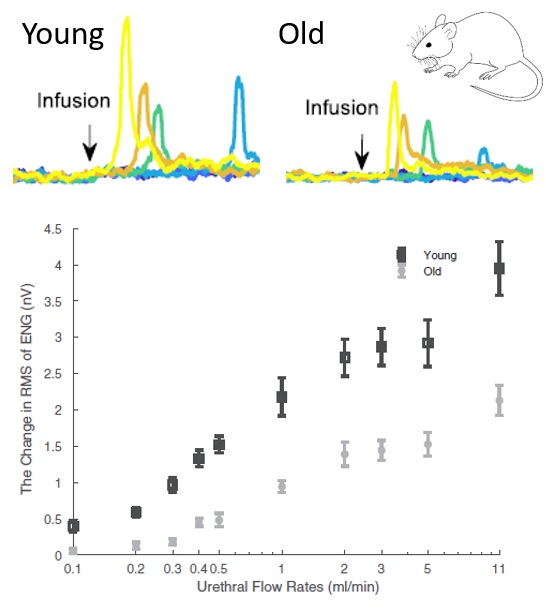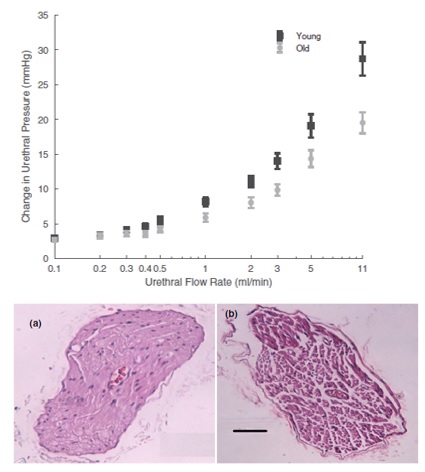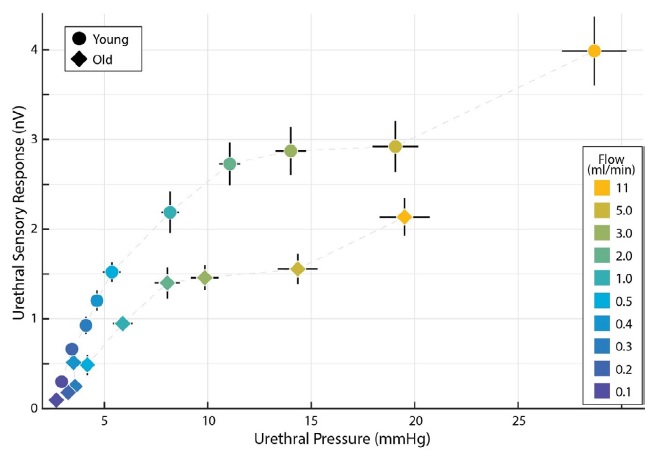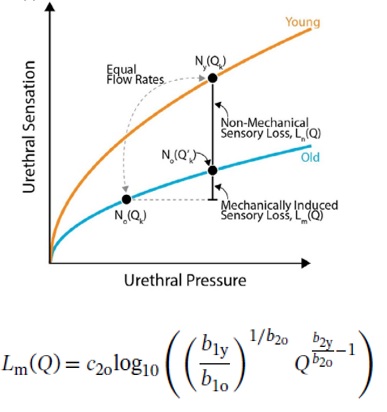Many people have declining urinary tract function as they age. Is it possible that weakening sensation (peripheral neuropathy) contributes? It is a concept that has been gaining credence for the past decade (e.g., see Smith’s opinion from 2009). We asked the basic question: “do urethral sensory neurons get weaker with age?”
To get at the answer we simultaneously recorded urethral flow, urethral pressure, and urethral sensory activation (pudendal nerve) in young and old rats. We find that whole nerve response to flow is greatly attenuated in older rats across all urethral flow rates. That is, for the same flow in old rats as young we get less sensory response in the nerve.

We also find a) urethral pressure itself is lower in old rats at the same flows, suggesting age-related mechanical changes to the urethra, and b) myelin loss in old rats, suggesting age-related neural changes. Meaning, the same flows generate more pressure in young rats.

This means some of the reduced urethral sensory outflow in old rats comes from mechanical changes to the urethra (less developed pressure leads to less neural activation), and some from neuropathy! Even holding pressure constant, old rats have less activation.

The field accepts that age-related underactive bladder is “multi-factorial”, that is, the bladder problems that arise from age occur for many, many reasons, and does not have a single underlying cause. It is this multifactorial nature that makes understanding (and treating) the problem so challenging – we can’t hang the case on a single gene mutation, or glucose level, or behavior. The problem seems to manifest from many sources.
Nevertheless, we would like to know how much of the sensory deficits we see in our rats derive from a reduced mechanical activation of the sensory neurons (i.e., less urethral pressure/tension is driving them in the first place) vs a reduction in the neuron’s capability of transmitting the signal once activated. We are able to combine the neural, pressure, and flow data to make this determination. We take the sensory response to the same flow rate (Q) between young and old rats to be the “total sensory loss”. Then we reason that if we increase the flow in old rats (Q’) to a level that produces the same pressure as the original flow does in young (Q), any sensory loss remaining is a transmission failure (or non-mechanical in nature). The portion that remains unaccounted for in the total sensory loss is then due to mechanical factors (or less activation of the sensory neurons). In this way, we determined that ~80% of the sensory loss comes from neuropathy.

We already know aging attenuates the effectiveness of urethral reflexes that we need for voiding, so we speculate that neuropathy begets voiding reflex failures that, in turn, leads to weaker voiding and underactive bladder symptoms. In the future, we are looking to turn the speculation into definitive answers. The afferent failure hypothesis of age-related non-obstructive UAB/OAB appears quite plausible.
Geramipour, A. and Z. C. Danziger (2021). “Age is associated with reduced urethral pressure and afferent activity in rat.” Physiological Reports 9(21): e15107.